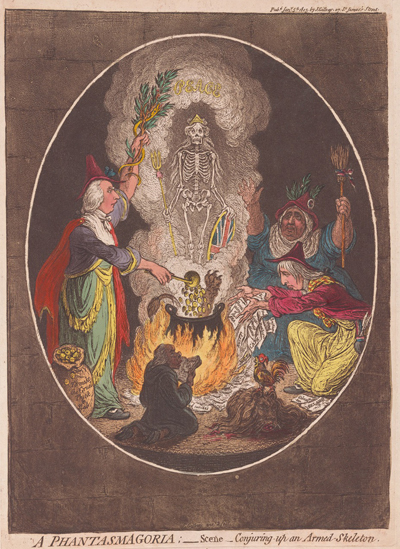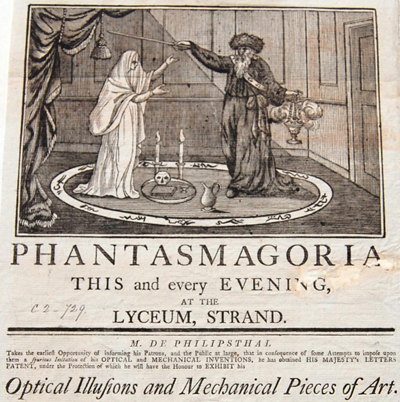A Phantasmagoria;
Scene: Conjuring Up an Armed Skeleton
This is one of several prints by Gillray whose subject is the Treaty of Amiens negotiated with Napoleon and the Directorate by the Addington administration and finalized in March, 1802. Like most of Britain, tired of warfare and taxes, Gillray had initially taken a wait and see attitude towards the new treaty (Sketch of the Interior of St Stephens, as it Now Stands (March 1, 1802), but in prints like The Nursery, with Britannia Reposing in Sleep (December 4, 1802), and The First Kiss This Ten Years (January 1, 1803), this measured support eventually changed to the suspicion that Britain had been lulled to sleep and taken advantage of with promises from Napoleon that would never be kept. In Phantasmagoria; Scene: Conjuring Up an Armed Skeleton, Gillray expresses his most explicit dissatisfaction with the Treaty and its most conspicuous supporters: Henry Addington, Lord Hawkesbury, Charles James Fox, and William Wilberforce.

© Beinecke Rare Book and Manuscript Library, Yale University
The scene, as presented, is loosely based on Act IV Scene 1 of Shakespeare's Macbeth where Macbeth seeks out the Three Witches to look into the future and learn of his fate. When Macbeth knocks, the witches are busily adding ingredients to their bubbling cauldron out of which will emerge three apparitions which will provide riddling answers to Macbeth's unspoken questions. The first apparition is an armed head, representing Macduff and his forces.
In Gillray's version, Addington, Hawkesbury, and Fox are the three witches. Prime Minister Addington (on the left) is ladling guineas from moneybags labeled "To make Gruel Thick & Slab"(Macbeth IV.i, 31). On the right, Secretary of State for Foreign Affairs, Lord Hawkesbury is feeding the fire with notes inscribed with the various possessions given up as part of the treaty, including "Egypt," "Malta,", and the "Cape" of Good Hope, as well as others like Switzerland which Napoleon was seizing in a pattern of barely restrained aggression. The Opposition Leader, Charles James Fox, who had long argued for peace with France greets the result with satisfaction. In the cauldron we can see that one of the previous ingredients sacrificed to this gruel was the British Lion itself whose tail and paw seem to be struggling to emerge from the pot. Its bloody severed head lies in the dust of the foreground while a cock with a French bonnet rouge crows triumphantly over it.
Out of the steaming brew which is labeled (top center) "PEACE" the apparition of an "Armed Skeleton" emerges. The trident, shield, and flowing hair identify this as Britannia, reduced to a mere skeleton of what she once was. And in spite of the "Hymn of Peace" being offered by the religiously naive Wilberforce, we can see that the olive branch offered by Addington contains a snake. And indeed all three witches have some indication of the French tricolour about their person suggesting that they are unwitting collaborators in Britain's destruction.
Gillray's audience, as spectator, is in Macbeth's position, wondering what the future has in store. And Gillray's grim answer is a greatly diminished Britain whose ministers are giving away its financial and strategic resources to France.
The particular form of this print is likely to have been prompted by two events: one was a recent performance of Shakespeare's Macbeth at the Theatre-Royal, Covent Garden on December 6, 1802, so the Witches scene may have been reasonably fresh in Gillray's mind four or five weeks later. The other impetus was undoubtedly the popularity of a technically sophisticated form of "magic lantern" show called Phantasmagoria which opened in London in October 1801 and which ran every night at the Lyceum until July 1802.

© Trustees of the British Museum
The performances evolved over the year and a half at the Lyceum; but they spawned so many imitators that M. De Philipsthal applied for and received a British patent for his creation in January 1802. Here is the description from an ad in the Morning Chronicle on June 15, 1802 which might have piqued Gillray's interest.
Shortly will be produced, in addition to the usual Performances at this place, which have aready been favored with the greatest applause, A CURIOUS OPTICAL ILLUSION called The SORCERER'S ANNIVERSARY, presenting in the most extraordinary manner a DANCE of WITCHES. . . The commencement of this New Performance presents to the eye of the Spectator ONE SINGLE FIGURE which multiplies itself into a great number more in an instant; and without any visible interference or agency, in a few moments, is surrounded with an incredible number of Witches, who, forming themselves into a curious groupe, dance about, and occupy the whole bounds of the Theatre.
Gillray's print is meant to imitate the way his witches might have appeared in a scene from Phantasmagoria projected on a stone wall.
Finally, Gillray may have remembered his etching work on Plate 3 of Hollandia Regenerata (1796?) which is similarly critical of the way the Batavian government had reduced the army (to which Hess belonged) to a skeleton of its former self.

Het Committé Militair
[1796?]
© Trustees of the British Museum
Sources and Reading
- Commentary from the British Museum on A Phantasmagoria; Scene: Conjuring Up an Armed Skeleton.
- Draper Hill, Mr. Gillray The Caricaturist, 1965, pp. 107 & 131
- "Phantasmagoria," Wikipedia
- "Macbeth," The Folger Shakespeare
- "Treaty of Amiens," Wikipedia
- "Henry Addington, 1st Viscount Sidmouth," Wikipedia
- "Charles James Fox," Wikipedia
- "Robert Jenkinson, 2nd Earl of Liverpool aka Hawkesbury," Wikipedia
- "William Wilberforce," Wikipedia
- Thomas Wright and R.H. Evans, Historical and Descriptive Account of the Caricatures of James Gillray #272.
- Thomas Wright and Joseph Grego, The Works of James Gillray, the Caricaturist; With the History of His Life and Times, p. X.
Comments & Corrections
NOTE: Comments and/or corrections are always appreciated. To make that easier, I have included a form below that you can use. I promise never to share any of the info provided without your express permission.